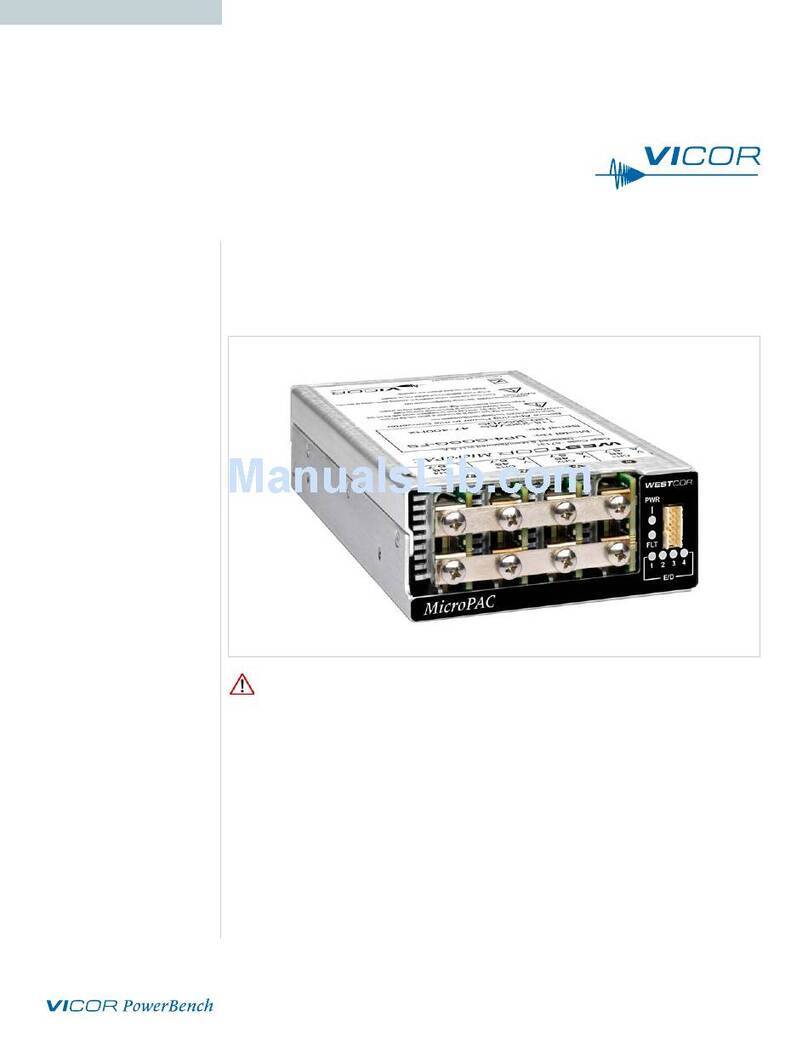PFC Mini-EL™
Power Factor Corrected AC-DC Switcher
Overview
The PFC Mini-EL is an extremely low profile switching power supply that combines the advantages of power fac-
tor correction and high power density. It can provide up to 6 isolated outputs (3 slots) and each slot accommodates
the following Vicor DC-DC Converters.
1st Generation: 1 Full Size (VI-200) or 2 Junior modules (VI-J00)
2nd Generation: 1 Maxi, 2 Minis (Micros cannot be used)
The use of these converters give the PFC Mini-EL the inherent power flexibility typical of all Vicor products.
Accepting input voltages of 85 Vac to 264 Vac, and 100 to 380 Vdc, the PFC Mini-EL can provide up to 1,500
Watts in a package size of 1.72" H (43,6mm) x 6" W (152,4mm) x 13.2" L (335,3mm). The PFC Mini-EL is facto-
ry configured to meet user requirements.
A special 7 output PFC Mini is available in four models. See page 16 for more details.
Standard Features
• Power Factor Correction: 0.99 at 115 Vac; 0.95 at 230 Vac
• Universal Input: 85-264 Vac, 47-500 Hz, or 100-380 Vdc
• Power Output: 1,500W at 230 Vac; 800W at 115 Vac
• Up to 6 isolated outputs (3 slots)
• Fan cooled
• Full power to 45°C; half power at 65°C
• Conducted EMI: 1st Generation (VI-200, VI-J00) 2nd Generation (Maxi, Mini)
FCC Class B FCC Class A
EN 55022 Class B EN 55022 Class A
(certain configurations meet EN55022 Class B.)
• Low ripple: 50mVp-p max. 15V & less; 150mVp-p max. >15V to 24V; 1%Vout p-p max above 24V
• Harmonic Distortion complies with EN61000-3-2
• AC Power OK status signal
• Autosense (for more information, see page 8 and page 12)
• Output overcurrent protection on all outputs
• Output overvoltage protection and Output overtemperature limiting (not applicable when using VI-J00)
• Ride-through (holdup) time: >20 ms at 1,200W load (nominal line)
• Size: 1.72" H (43,6mm) x 6" W (152,4mm) x 13.2" L (335,3mm)
• Safety Agency Approvals: CE Marking, CTÜVUS
Optional Features
• Extended temperature range output converters
• Current Share Board - See page 20
• BatMOD current sources available (see page 16 for more information)
• Connector kits available (#19-130047 and # 19-130050)
Part Numbering
PFC Mini-EL PMx1-x2 x3-xxx -EL x1Number of outputs
e.g. PM4-22-501-EL x2Number of 1st Gen VI-200 & VI-J00 modules
x3Number of 2nd Gen Maxi and Mini modules
xxx Sequential number assigned by Westcor
EL Extended length
Rev. 12/2003 Vicor 800-735-6200 Westcor Division 408-522-5280 Applications Engineering 800-927-9474 Pg. 3
PFC Mini-EL Design Guide





























